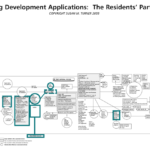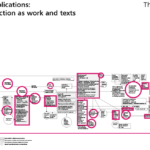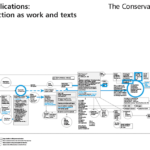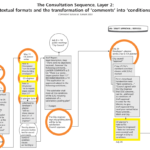I developed the mapping conventions and technique while I was learning with other city residents how to intervene in local municipal land development processes and at home sketching out the text-based work processes as I was participating in them. I was talking to planners, engineers and city councillors about their work. I mapped layers of complex organization. One focussed on the text-based sequence of consultation by the City and the conservation agency planners and engineer. I wanted to learn how consequential legal clauses were produced for the official text called the conditions of development; the planning discourse calls it resolving concerns through conditions.
Creating a big picture of the whole official land development approvals process as it actually went on was a way to learn and see how things were being put together in time and talk and texts as they were produced and circulated and read and discussed.
When I began to graphically map George Smith’s advice was: “take a little piece” and do a proto analysis.” Doing that, I could show him the social organization in it, how individuals’ experiences emerge within the particular social relations (Smith’s ‘text-based’ conception), their work, their actual participation in a socially organized sequence of institutional action.
This is what and how the ethnographer discovers, piece by piece, the coordination work and mechanisms of coordination that people engage in, within these ongoing relations. That coordination is productive work that people do.
My dissertation was my first full institutional ethnography and where I developed mapping and its conventions. Learning about planning, talking to planners, engineers and councillors about their work and the process that was going on, we neighbours who got together to intervene came to identify ourselves in planning process terms. We were the residents in relation to a particular site for development. We wanted to stop the destruction of trees and ravine here and the forests, farms and fields that was happening all around the city.
Mapping actual text-based work processes helped to really see people’s work and how it fit into a municipal process that goes on across the province, country and elsewhere. It showed how different professional discourses operate, intersect, and result in routine ongoing land development decisions and environmental destruction, while taking technical, social, environmental and ‘residents’ concerns into account in a so-called ‘democratic’ process.
We neighbours effectively changed the development plan, scale of the development to fit beside the natural ravine, and brought the city to order the developer to pay to replace all trees and participate in a community tree planting of 3500 trees. A significant result was the creation of neighbourhood associations across the city and change to how the City informs residents of developer’s proposals so they can participate earlier in the process. In our process, we called meetings where city councillors and staff, consultants, and commenting agencies all came, so everyone could speak and be listened to together. Unheard of.
See Resources: Dissertation



